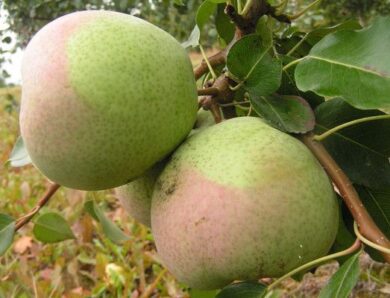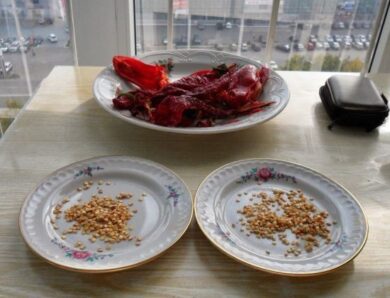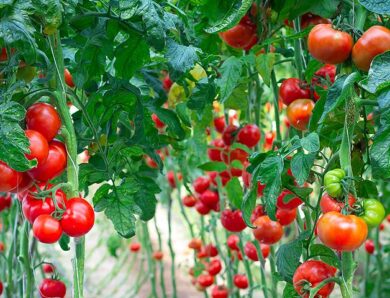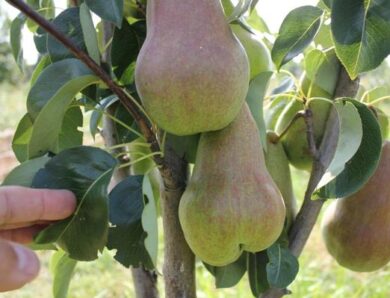Apple Ligol: description and characteristics of the variety
The apple tree has long been an ornament of any garden, and very often, due to the huge variety of varieties, it is not easy for farmers to decide, what exactly they want to grow on their plot. In this article we will describe the Ligol apple tree and consider its main characteristics.
Variety description
Ligol apple tree is a winter variety, bred in Poland by crossing varieties Linda and Golden Delicious. Numerous positive reviews confirm its high yield and winter hardiness, thanks to which even the strongest winter frosts are not terrible for a tree.
Main characteristics
The apple tree is not too large - the trees reach on average 3-4 meters in height. The branches are long and strong, located at an angle 60-85 degrees relative to the trunk. The crown is not too thick, usually has a pyramidal shape, however, if desired, the owner of the apple tree can form its shape on their own. New shoots appear in plants fairly quickly (this is one of its features), due to which its productivity increases several times. Apple leaves are oblong, slightly pointed, emerald color. There are small notches on the edges. Ligol blooms with beautiful white flowers, which fade quickly enough - usually they have enough period in 10 days.
Ligol apple variety boasts huge fruits (some of them reach masses over 300 grams). In shape, they differ little from other varieties of apples - they are round-conical, with a short peduncle. Their skin is shiny and smooth, has a greenish-yellow color, and the cover color is bright red. The flesh is creamy, very juicy and tender, the fruit tastes very sweet, with a slight sour note.
Landing
Planting and caring for this tree is a simple matter, however, there are some nuances to follow, that productivity was at the highest level. First of all, you need to choose a suitable place for planting. The soil of these plants prefer fertile, with good breathability, therefore, loamy soils will be the best option. exept this, the proximity of groundwater is excluded, which contributes to the rapid decay of the root system. This is a description of the ideal terrain and soil, on which a tree can grow, if you do not have any of these factors, it can be compensated, providing additional drainage, top dressing, etc.. d. In skilled hands, the plant will always bloom and bear fruit.
Before landing (for two weeks for autumn planting, and in the autumn - for spring), the site must be dug up and fertilized (manure, saltpeter). Then the pit is dug meter by meter, and till 90 cm in depth. The soil is mixed with compost and fertilizers, after that the seedling is placed in the hole, its roots must be straightened and well compacted with earth. The root collar should be on 4-6 see above ground level, but for that, so that the tree does not break from the wind - it is tied to a peg, killed next to a tree.
Pollinators
Ligol - self-fertile, so for that, so that the flowers are pollinated, it is necessary to place several other pollinators on the site. The most compatible is called the Mac, Fuji, Champion, and Gloucester Spartan. For, to finally decide, which one will be most suitable for your site, it is recommended to study their description in detail and make the right choice. It is worth noting, as for some varieties Ligol itself is an excellent pollinator (Idared, Jonagold).
Care
In order for the tree to bloom and enjoy a wonderful harvest, it is recommended to follow some simple rules. The soil around the trunk should be weeded and loosened in a timely manner, to provide oxygen access to the roots (this should be done after each watering). Further, regular pruning of branches allows you to form the correct shape of the crown and protect the tree from pests. I must say, that if desired, you can add a spindle-shaped crown, which will allow you to plant apple trees at a fairly close distance from each other.
in addition, timely preventive actions will protect plants from diseases, and fertilization - will strengthen and increase the overall resistance. Nitrogen-containing fertilizers are used in the active growth phase, on the eve of winter - humus and peat. It is also necessary to whitewash the trunk in a timely manner. In addition to the above steps, keep in mind the need to water the plant during flowering, when tying the fruit, and a few weeks before they ripen. Water for this purpose needs to be used warm and settled, with the growth of the apple tree increasing its number.
Diseases and pests
This apple tree has low resistance to bacterial blight, and under adverse conditions is exposed to wood diseases. This disease manifests itself in the form of black or dark brown spots on the wood and leaves of the plant. Various antibiotics are used to fight this disease, and also removes infected branches (so many, as possible). Although it is worth noting, that this plant has a very high resistance to scab and powdery mildew, which makes life much easier for their owners. in addition, for protection against rodents it is necessary to wrap a trunk with a grid or roofing material.
Pros and cons
The advantages of this variety include high resistance to low temperatures (tolerates even the most severe frosts), good yield, early fertility, resistance to the most common diseases - powdery mildew and scab, long shelf life and ease of transportation. The disadvantages are the high susceptibility to bacterial burns (quite serious disease of the fruit tree), defeat by tanning of the skin and subcutaneous spots with improper storage.
Video "Ligol apple tree variety"
In this video you will learn about the features of the winter apple variety Ligol.




